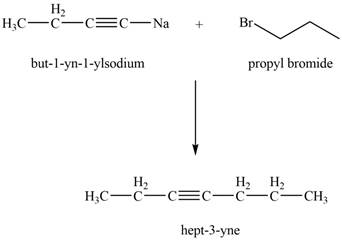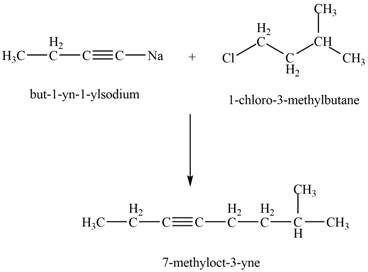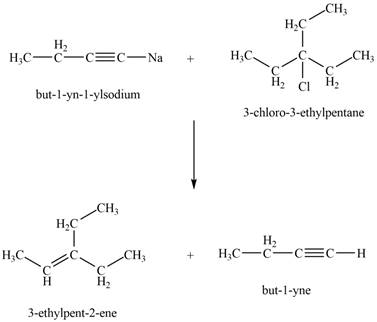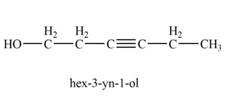
Concept explainers
(a)
Interpretation: The product that is formed by the reaction of
Concept introduction: The replacement or substitution of one functional group with another different functional group in any
Answer to Problem 11.20P
The product that is formed by the reaction of

Explanation of Solution
The reaction of

Figure 1
Thus, the product that is formed by the reaction of
The product that is formed by the reaction of
(b)
Interpretation: The product that is formed by the reaction of
Concept introduction: The replacement or substitution of one functional group with another different functional group in any chemical reaction is termed as substitution reaction. The nucleophilic reaction that consists of bimolecular as well as bond-making and bond-breaking steps is termed as
Answer to Problem 11.20P
The product that is formed by the reaction of

Explanation of Solution
The reaction of

Figure 2
Thus, the product that is formed by the reaction of
The product that is formed by the reaction of
(c)
Interpretation: The product that is formed by the reaction of
Concept introduction: The bimolecular elimination reaction that favours the removal of a HX substituent from an
Answer to Problem 11.20P
The product that is formed by the reaction of

Explanation of Solution
The reaction of

Figure 3
Thus, the products that are formed by the reaction of
The products that are formed by the reaction of
(d)
Interpretation: The product that is formed by the reaction of
Concept introduction: The replacement or substitution of one functional group with another different functional group in any chemical reaction is termed as substitution reaction. The nucleophilic reaction that consists of bimolecular as well as bond-making and bond-breaking steps is termed as
Answer to Problem 11.20P
The product that is formed by the reaction of

Explanation of Solution
The reaction of

Figure 4
Thus, the major product that is formed by the reaction of
The major product that is formed by the reaction of
(e)
Interpretation: The product that is formed by the reaction of
Concept introduction: The replacement or substitution of one functional group with another different functional group in any chemical reaction is termed as substitution reaction. The nucleophilic reaction that consists of bimolecular as well as bond-making and bond-breaking steps is termed as
Answer to Problem 11.20P
The product that is formed by the reaction of

Explanation of Solution
The reaction of

Figure 5
Thus, the major product that is formed by the reaction of
The product that is formed by the reaction of
(f)
Interpretation: The product that is formed by the reaction of
Concept introduction: The replacement or substitution of one functional group with another different functional group in any chemical reaction is termed as substitution reaction. The nucleophilic reaction that consists of bimolecular as well as bond-making and bond-breaking steps is termed as
Answer to Problem 11.20P
The product that is formed by the reaction of

Explanation of Solution
The reaction of

Figure 6
Thus, the major product that is formed by the reaction of
The product that is formed by the reaction of
Want to see more full solutions like this?
Chapter 11 Solutions
Organic Chemistry
- Consider the following test samples: A. heptane D. toluene B. hexane E. benzene C. hexene Which of the test samples will react with conc. H2SO4 ?arrow_forward1. Is Hexane and Benzene soluble in each other? 2. Is Hexane and 1-hexene soluble in each other? 3. Is Bromine (Br2) soluble in water?arrow_forwardWhat mass of 2-bromopropane could be prepared from 25.5 g of propane? Assume a 100% yield of product.arrow_forward
- What is the name of the alkene? CH3CH=CHCH=CH2arrow_forward1. what grouo does the ff organic compound belong? a. ketone b. ether c. cyloalkane d. esther 2. what group does the ff organic compound belong? a. amide b. azo c. nitrile d. amine 3. what is the priority functional group of the ff organic compound? a. carboxyl b. hydroxyl c. carbonyl d. hydroxidearrow_forwardWhy cant you have 1 ethyl 1 hexanolarrow_forward
 Chemistry & Chemical ReactivityChemistryISBN:9781337399074Author:John C. Kotz, Paul M. Treichel, John Townsend, David TreichelPublisher:Cengage Learning
Chemistry & Chemical ReactivityChemistryISBN:9781337399074Author:John C. Kotz, Paul M. Treichel, John Townsend, David TreichelPublisher:Cengage Learning Chemistry & Chemical ReactivityChemistryISBN:9781133949640Author:John C. Kotz, Paul M. Treichel, John Townsend, David TreichelPublisher:Cengage LearningChemistry: Matter and ChangeChemistryISBN:9780078746376Author:Dinah Zike, Laurel Dingrando, Nicholas Hainen, Cheryl WistromPublisher:Glencoe/McGraw-Hill School Pub Co
Chemistry & Chemical ReactivityChemistryISBN:9781133949640Author:John C. Kotz, Paul M. Treichel, John Townsend, David TreichelPublisher:Cengage LearningChemistry: Matter and ChangeChemistryISBN:9780078746376Author:Dinah Zike, Laurel Dingrando, Nicholas Hainen, Cheryl WistromPublisher:Glencoe/McGraw-Hill School Pub Co Chemistry: The Molecular ScienceChemistryISBN:9781285199047Author:John W. Moore, Conrad L. StanitskiPublisher:Cengage Learning
Chemistry: The Molecular ScienceChemistryISBN:9781285199047Author:John W. Moore, Conrad L. StanitskiPublisher:Cengage Learning
 Chemistry: An Atoms First ApproachChemistryISBN:9781305079243Author:Steven S. Zumdahl, Susan A. ZumdahlPublisher:Cengage Learning
Chemistry: An Atoms First ApproachChemistryISBN:9781305079243Author:Steven S. Zumdahl, Susan A. ZumdahlPublisher:Cengage Learning





